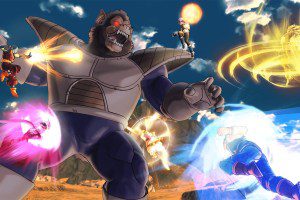The 5 Best ‘Dragon Ball’ Games You Can Play Right Now
Few franchises have the ongoing generational impact of Dragon Ball. Created by Akira Toriyama, the martial arts manga began in 1984, was adapted as an anime in 1986, and by the late Nineties had been translated from Japanese to dozens of languages, becoming a global phenomenon. The granddaddy of modern anime, Dragon Ball’s ubiquity extends beyond niche subculture — everyone, everywhere is likely to recognize its protagonist, Goku. He’s had not one, but two balloons in Macy’s Thanksgiving Day Parade.
For those who may only be partially familiar, Dragon Ball began as a broad adaptation of the classical Chinese epic Journey to the West, starring a monkey-tailed boy named Goku on a hero’s quest to become the world’s strongest fighter. The original manga (then anime) continued with two sequel series, 1988’s Dragon Ball Z — which is the one most people know and the bulk of the franchise’s media is based on — and 2015’s Dragon Ball Super. Both follow the ongoing stories of an adult Goku and his extended family and friends taking on world-ending threats with increasingly ridiculous stakes. This week, the latest addition to the saga began with Dragon Ball Daima, the final series in the franchise worked on by Akira Toriyama, who died in March of 2024.
Being a staple of Japanese, and later global, pop culture, it’s obvious that there would be plenty of Dragon Ball video games. There’s actually over 150; the problem is that the majority of them aren’t really all that good. Certain sub-series were hits, like Super Butōden or Budokai Tenkaichi, both of which were fighting games that birthed waves of iterative sequels. But which game is considered the best likely comes down to whichever was a player’s favorite growing up.
For me, that’s 1997’s Dragon Ball GT: Final Bout for the original PlayStation, but by all accounts, it’s considered a terrible game. For someone else, it might be 2002’s The Legacy of Goku for Game Boy Advance. It’s many things to different people.
Like other long-running multimedia franchises like Star Wars, Dragon Ball’s decades of cultural saturation means that there have been many different types of games across all genres to explore. Fighting is a clear one — it’s a martials arts saga after all — but some of the best entries in the series’ gaming canon have also been action games and RPGs.
One thing’s for sure, there’s no shortage of Dragon Ball games to find that will satisfy any individual palate, but it’s also true that now is probably the best era ever to dive into. With many older, clunkier games not readily available outside of emulation, new fans are likely to pick up a more recent release anyway, but those also happen to be some of the greatest.
But which should you play? Here’s Rolling Stone’s list of the best Dragon Ball games you can play right now.
-
‘Dragon Ball Xenoverse 2’ (2016)
Image Credit: Bandai Namco For anyone looking to roleplay in the Dragon Ball world, the Xenoverse sub-series is the perfect fit. 2016’s Xenoverse 2 is the latest entry, and has seen regular updates including a specific modern version released for PlayStation 5 and Xbox Series X|S.
In Xenoverse, players can create their own custom character to match wits and trade fists with the sprawling cast of the Dragon Ball story. The story revolves around the custom protagonist, the Time Patroller, who is tasked to maintaining the proper flow of history, protecting reality from threats. DBZ fans know that time-travel shenanigans are a regular trope in the series, and Xenoverse’s setup doesn’t just fit in but allows players to relive major moments from different famous sagas, with different twists and changes finding their way in. With branching narratives, players themselves can control how the story progresses.
Xenoverse also has tons of online multiplayer options and years’ worth of expansions and downloadable content, making it a massive experience for anyone just picking up it now. Unlike most Dragon Ball games, which are either single-player or focus on competitive multiplayer, Xenoverse’s online servers has a cooperative PvE (player vs. enemy) slant that’s rare for the franchise.
-
‘Dragon Ball: The Breakers’ (2022)
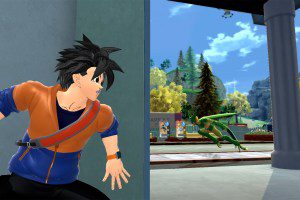
Image Credit: Bandai Namco Set in the same universe as the Xenoverse games, The Breakers is one of the most bizarre takes on a Dragon Ball game ever. While most are powerful fantasies, letting players unleash the full might of the universe’s strongest warrior, The Breakers takes a more methodical approach and emphasizes hard-earned survival.
An online asymmetrical multiplayer game in the vein of 2016’s horror hit Dead by Daylight, The Breakers pits seven players as ordinary people trapped in a Temporal Stream, wherein one of Dragon Ball’s most iconic villains like Frieza or Buu is on the hunt (controlled by an eighth player). The mostly powerless survivors must tread lightly and work together to prevent the villain (called a Raider) from evolving to its full power and crushing everything in their path.
Anyone who’s played (or watched) an asymmetrical game like Dead by Daylight, Friday the 13th: The Game (2017), or this year’s Killer Klowns from Outer Space knows that the high-tension thrills of survival against an unstoppable force can make for hyper addictive loop.
By setting the strongest fighters aside to focus on being the little guy, The Breakers offers one of the most unique and high concept takes on Dragon Ball lore.
-
‘Dragon Ball Z: Kakarot’ (2020)
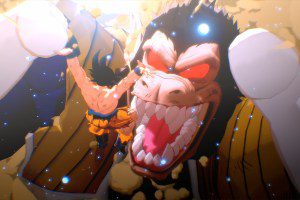
Image Credit: Bandai Namco Whereas Xenoverse and The Breakers put a player-driven spin on the world of Dragon Ball, 2020’s Kakarot adheres to the series’ plot slavishly. A single-player action role-playing game, Dragon Ball Z: Kakarot is essentially a playable version of the anime, reenacting every major saga and famous plot point to a tee.
Controlling like popular action RPGs like Dragon Age: Inquisition (2014), Kakarot (titled after Goku’s true name) will be familiar to anyone who’s played a modern action game. It serves as an intuitive and engaging way to fly through the well-worn story of Dragon Ball Z and parts of the sequel series Super in a more immersive, less passive way.
With massive battle sequences revisiting major plot points from the show like Goku’s fight with Great Ape Vegeta or going Super Saiyan for the first time against Frieza, Kakarot has the dynamic action of the best DBZ fighting games without the need to compete. With tons of side quests, open environments to explore, and RPG-style progression systems, it’s a long-term investment for anyone looking for a deep single-player experience.
-
‘Dragon Ball FighterZ’ (2018)
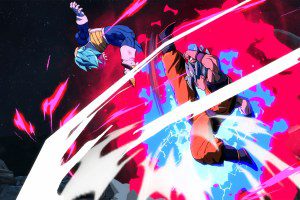
Image Credit: Bandai Namco While most Dragon Ball games are developed by studios like Bandai Namco subsidiary Dimps, there are some rare exceptions when another developer with their own house style steps in. With Dragon Ball FighterZ (2018), that developer was Arc System Works, famous for fighting-game series like Guilty Gear and BlazBlue.
Unlike most modern Dragon Ball fighting games, which tend to be fully 3D, FighterZ harkens back to the days of Butōden with a 2D brawlers (technically 2.5D since the in-game camera moves around a lot). But going a step further, the game also employs a 3v3 tag-team mechanic that, along with its intense speed and over-the-top action, makes FighterZ resemble another arcade classic: Marvel vs. Capcom 2.
The parallels are clear in the game’s design, which is frenetic. In many ways, FighterZ feels like a truer successor to MvC2 than any of that series’ own sequels. While other Dragon Ball sub-series opt not to power scale its characters — meaning that characters who are weak or strong in the anime remain that way in the games — FighterZ aims for balance, allowing lower-tier characters like Yamcha or Krillin to have a chance against world-ending threats like Broly. That balance and tightness of play made FighterZ a major competitive game at the pro level, featured on the bill at esports events like Evo in 2018, 2019, and 2024.
With its pedigree, FighterZ remains not just one of the best Dragon Ball games, but one of the best fighting games ever.
-
‘Dragon Ball: Sparking! Zero’ (2024)
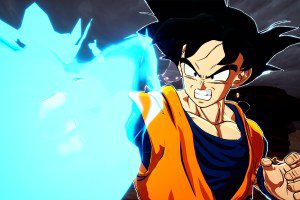
Image Credit: Bandai Namco Released on Oct. 11, Sparking! Zero is probably the most Dragon Ball game ever made. A return to the anime arena fighter format that made the popular Budokai Tenkaichi sub-series a favorite, Sparking! Zero is just about every fan’s dream.
As with most Dragon Ball games, Sparking! Zero’s story mode retells the anime’s well-known sagas, all the way from the beginning of Dragon Ball Z through the more recent Super. Unlike FighterZ, Sparking! Zero specifically sticks to the canon on how powerful each character should be, with different versions of each from throughout the series’ chronology having different levels of strength. This means that there’s no balance between low- and high-tier combatants, but that’s by design. The game doesn’t just painstakingly adapt the anime’s plot but leans heavily on the joys of fanfiction to let players try out different scenarios that relish in the “What if?” style of storytelling.
What if an early Saiyan Saga-era Goku went up against the God of Destruction Beerus? It’d be an impossible fight for Goku — but here, you can try it.
With 182 playable characters, Sparking! Zero plunders the depths of the Dragon Ball lore to make sure everyone is there, regardless of how small their role or the validity of their place in canon. By truly recreating the look, feel, and spirit of the anime, Sparking! Zero might just be the only Dragon Ball game you ever need to play.


